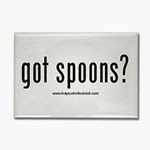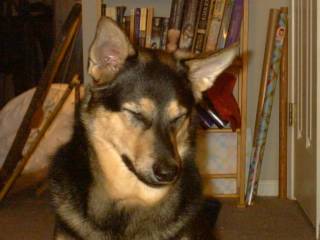The subject today is retinas. Mine, to be precise, although this first picture isn't -- mine, that is. This is a picture of a healthy retina from a medical site here on the web. See how nice and shiny and pink it is?  The light spot to the right with all the blood vessels branching from it is actually the optic nerve, while the darker pink area in the center of the field is the macula. The macula is the portion of the eye where the retinal tissue is very thin, and where the eye is able to produce the fine vision that allows people to focus on print, small objects, and fine details. You'll notice that this area has no blood vessels snaking through it. The tissue here is far too thin for even the smallest blood vessels.
The light spot to the right with all the blood vessels branching from it is actually the optic nerve, while the darker pink area in the center of the field is the macula. The macula is the portion of the eye where the retinal tissue is very thin, and where the eye is able to produce the fine vision that allows people to focus on print, small objects, and fine details. You'll notice that this area has no blood vessels snaking through it. The tissue here is far too thin for even the smallest blood vessels.
The eye disease that I have, presumed ocular histoplasmosis syndrome or POHS, causes the body to send blood vessels into this area of fine vision. The vessels rupture the tissue, destroying its ability to absorb light and transmit information, and they also rupture, obscuring even more vision with blood. None of this can be seen from the outside, but it can completely obscure the center vision should treatment be unsuccessful. The retinal results look like this second picture, which is an actual photo of my left retina.
None of this can be seen from the outside, but it can completely obscure the center vision should treatment be unsuccessful. The retinal results look like this second picture, which is an actual photo of my left retina.
As you can see, the macula and the even more delicate region of the fovea at the center of the macula have been completely destroyed by rogue blood vessels, ruptures, and scarring. The area around the optic nerve also shows similar signs of bleeds and scarring, but bleeds that far from the center don't actually affect my vision and the doctors have never indicated that they present any danger to the optic nerve itself.
This final picture shows my right retina -- the one that had a bleed fifteen years ago and which Dr. Matthew Thomas at Barnes Retina Institute was able to remedy somewhat by taking the whole thing apart and removing the blood vessel, and then putting the eye back together again.

The procedures involved have much more glamorous and imposing sounding names like "vitrectomy" "sub-macular removal of the neo chordial vascularization" etc., but you get the general idea. In this last picture, you can see the black crusty scars of bleeds near the optic nerve, but only two black spots near the macula. One is a laser scar, the first treatment attempted on this eye when the first blood vessel ripped through the retinal tissue. The laser burns through the retina, destroying it in the hope of cauterizing the vessel and preventing more bleeds. This didn't work, and the second black spot (the larger) is where the second blood vessel broke through with such force and enthusiasm that my center vision was completely obscured within just a few seconds.
The dark shading around the macula represents areas where the tissue is starting to atrophy. The process of removing the offending blood vessel and the pooling blood involved separating the retina from the back of the eye, and separating it from the nutrient layer underneath. Over time, areas in which the nutrient layer and the retina did not fully heal together have started to atrophy which will eventually cause a gradual loss of acuity in and of itself.
The shiny whitish areas in the macula of this eye are places where the pretty pink pigment decided that enough was enough, and it bugged out all in a few seconds, causing me to think that a Kentucky Fried Chicken sign announcing "The New Honey Barbecue Wings" would be the last thing I'd seen on earth.
But, thankfully, this was not the case, as the bug-out was just a precursor to the second bleed in this eye. My vision cleared after several minutes, we made yet another flying trip to a hospital an hour and a half away, and my vitreo-retinal specialist at the time, Dr. David V. Poer, said, "you shouldn't have been able to see that!" -- not the first or the last time this phrase was used in reference to me and my eyes. (grin)
The smaller whitish dots out from the center are additional histo scars which may be drawing blood vessels to them. These scars, the pigmentation migration, and the fact that for some unknown reason my pupils now remain dilated to about 7 or 8 millimeters all the time are some of the causes of my extreme light sensitivity. But that's a topic for another time.
Currently, my vision is changing yet again. About a week ago, I noticed some changes in my vision, Careful examination on an amsler grid shows changes in all four quadrants, blurred places, bent lines, glittery shapes, flickering shadows, all of which indicate that the disease is again active, and that something is coming. Probably a blood vessel, maybe more than one. But some portion of it seems to be headed directly for the center of the macula. The ER noted that my acuity in the good eye had dropped from 20 / 40 to 20 / 70. So began the frantic trips to the retinal specialists.
Dr. Thomas with his fancy tools, including the new OCT-whatchamacallit which functions like ultra sound and can pick up the tiniest amounts of fluid under the retina are going to try to determine when the threat warrants treatment with the cancer drug Avastin. So far, we are in a holding pattern. It's clear that something is going on, but so far, the photos and angiograms aren't showing any bleeds. Nor does this nifty new thing that works like ultra sound show any fluid yet; with my history, it's just a matter of time, but the docs can't start treatment until they have something to shoot at.
Personally, I wish the whole thing would hurry up. Being blind is only a pain in the butt. But the process of loosing vision is hell on earth. My mom flew in from PA on Monday to go with me to the first appointment with a local guy. She'll be staying indefinitely and working via e-mail, etc. From my history, it'll all be over but the shouting in about a month, maybe a bit more. Once they find something they can target, the newest treatment involves injections into the eye with Avastin, a cancer drug, about every four to six weeks. This will cause the blood vessels to wither and retreat and allow what parts of the retina that can heal a chance to do so, but whatever is destroyed when the blood vessel bursts through will be lost for good.
I'm not at all sure how long my nerves will tolerate having them stick needles in my eye while I'm awake, though I'll be requesting some significant sedatives. So I don't know how this will play out. Some people have continued the treatments for years; some have three or four and then the disease goes back into remission.
Knitting is a wonderful consolation; a friend here has started to record the pattern instructions for the shawl I'm working on into audio, since I can't stand looking at the charts now, and may never be able to again.
I've also started selling my home-made stitch markers in the local yarn store and earned enough to get a spindle and a bag of fiber. I had everyone in the local waiting rooms fascinated with watching me spin (grin) while we waited for eyes to dilate, photos to process, or other time consuming tortures. "Sitting and spinning" has multiple meanings for me at the moment, so I'm glad at least one of them is productive!
More pics of fiber and fripperies in the next post, and perhaps that promised discussion of skip tags!




















![[Blind & VI Web Ring]](http://www.viguide.com/images/bvi1.gif)









